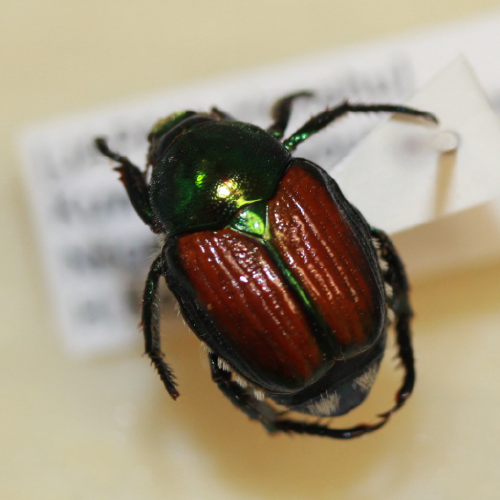Japanfer
Profile
The Japanese beetle can cause great damage to various plant species. In the EU it is listed as a priority quarantine pest and the occurrence of the beetle is reportable.
Appearance

The Japanese beetle, a representative of the leaf horn beetle family (Scarabaeidae), is about 10 mm long and 6 mm wide. The head and the thorax are metallic green colored, the elytra are coppery iridescent. The twelve white tufts of hairs along the abdominal margin are conspicuous. The larvae are shaped like grubs and grow up to 30 mm in size.
Possibility of confusion
The Japanese beetle can be confused with the native garden beetle(Phyllopertha horticola), but can be distinguished from it by the characteristic five white tufts of hair on each side of the body next to the wings and the two white tufts at the end of the abdomen.
Biology
The Japanese beetle develops one generation per year. The beetles emerge from the ground in May/June, feed on leaves, flowers, and fruits in several cycles, and mate. Females lay 40 to 60 eggs in moist meadows and pastures. The eggs hatch into larvae that live underground in the soil and feed on roots. The larvae overwinter in the third larval stage at a soil depth of about 15 to 30 cm. In spring from about + 10 °C outside temperature, the larvae migrate again to the upper soil layers, where feeding continues, and pupate after four to six weeks. From about mid-May, the beetles hatch. The development cycle of the Japanese beetle thus lasts one year.
Damage symptoms
The feeding activity of the beetles can be seen on the above-ground plant parts (leaves, fruits, flowers). Here, in case of mass occurrence, skeletal feeding up to bare feeding of the affected host plants may occur. Larval feeding on the roots reveals damage to the soil surface of lawns and pastures, where there is marked browning as the grasses and/or herbaceous plants die.
Host plants
The host plant range of the Japanese beetle is very wide and includes more than 300 plant species among trees, shrubs, wild plants and crops. The following host plants are particularly relevant to agriculture: Grapevine, apple, cherry, peach, apricot, plum, hazelnut, corn, soybean, rose and many more. In addition, the Japanese beetle still eats on deciduous trees, such as maple, linden, elm and poplar. The larvae feed on the roots and underground stems of a variety of vegetable and garden plants, ornamentals and grasses.
Distribution
The Japanese beetle originates from Japan and the Far East of Russia. Since the beginning of the 20th century, the beetle has been spread in North America and Canada by introduction. In the 1970s, the Japanese beetle was first introduced to Europe (Azores), on the European mainland it was first detected in Italy (Lombardy) in 2014, in Switzerland (Ticino, Basel area) since 2017, and in Germany (Baden-Württemberg) in traps in 2021 and 2022. No Japanese beetle has yet been found in Austria.
Spread
The Japanese beetle can spread via various routes. It can be unintentionally carried by any means of transport (e.g. car, train). Eggs and larvae can travel with soil through plant trafficking from infested areas to other areas. The beetles themselves can also spread independently over short distances (about 500 to 1,000 m per year). The risk for a settlement of the Japanese beetle is high in Central Europe due to favorable climatic conditions and the availability of suitable food for the beetle.
Economic importance
In case of mass occurrence of the Japanese beetle, considerable damage can be caused both by the feeding activity of the beetles on above-ground plant parts of herbaceous and woody plants and by the feeding of the larvae on the roots in lawns and pastures. This can result in major crop losses and also plant death.
Prevention and control
The most important measure to prevent the spread of the Japanese beetle and its successful control is the early detection of its occurrence. This can be achieved by official monitoring measures and targeted controls. In Austria, on the one hand, import controls of host plants at first entry points (e.g. at Vienna airport) are carried out by the Federal Office for Food Safety, on the other hand, the Official Plant Protection Services in the federal provinces check compliance with domestic market regulations and are responsible for farm inspections. In case of an occurrence of the Japanese beetle, control measures are ordered by the responsible Official Plant Protection Services in the federal states.
Phytosanitary status
The Japanese beetle is listed as a priority quarantine pest in the EU, and its occurrence is therefore reportable.
Specialized information
Projects
EU-ERANET EUPHRESCO project EPIDISARTH: Improved knowledge about epidemiology and distribution of priority invasive and (re)emerging arthropod pests in fruit crops and grapevines (e.g. Aromia bungii, Popillia japonica, Halyomorpha halys), 01.03.2021 - 01.02.2023
Last updated: 12.04.2023
automatically translated